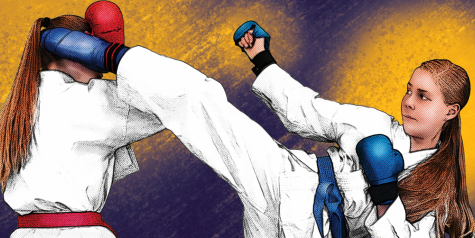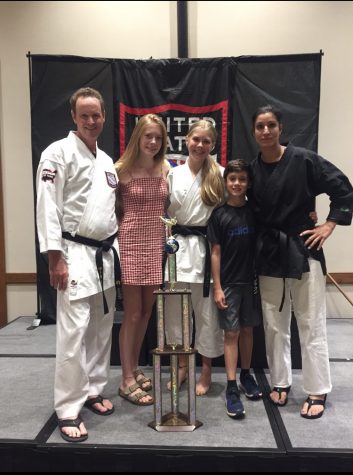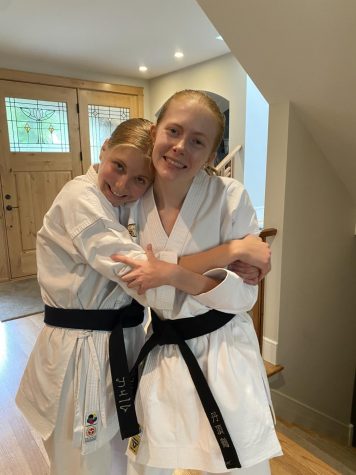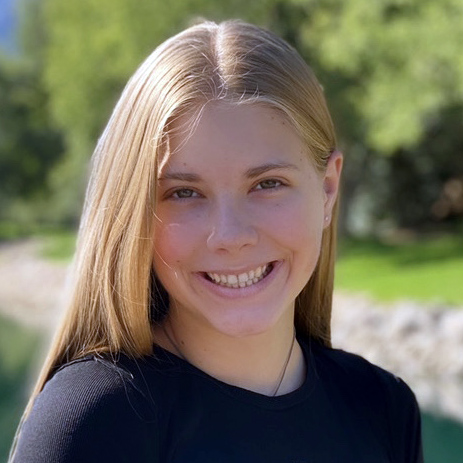An Evaluation of Cobra Kai by a Third Degree Black Belt
Disclaimer: I understand that Cobra Kai was produced with the intent of entertainment. In this article, I judge the martial-arts aspects on accuracy and evaluate if I like the show based on my experience. This article is lighthearted in intent and meant as an inside look at how I view the show as a nearly ten-year practitioner.

The Karate Kid was exaggerated, iconic karate at its best—and I loved it. Naturally, like a fan of anything is, I was skeptical of a spinoff. However, with Cobra Kai taking over Netflix and the questions I’ve received as a real black belt about its validity, I caved and watched the show. Here’s what I learned:
The All Valley Under 18 Championship was glorious for the victor and devastating for the runner-up. Cobra Kai tells the story of Johnny LaRusso (William Zabka) at his lowest. Whereas The Karate Kid was black and white, good and evil, Cobra Kai is all about the grey area. As a viewer, you can root for one party in an episode and then completely switch sides in the next.
To put it simply: the Johnny-Daniel rivalry explodes, but now the new generation of karate kids have their own alliances and romances, causing more conflict than imaginable. The show is full of fights, drama and power-hungry teens that blow everything out of proportion.
The show doesn’t fall short in The Karate Kid nostalgia with plenty of flashbacks and Easter eggs. However, aside from the show’s assets, there is still one pressing question: how does it represent the world of martial arts? This is my full analysis of Cobra Kai as a Sensei, third-degree black-belt and long-time competitor:
The Karate: 5/10

I must begin by clarifying that “I do karate” is quite a broad statement. Karate has hundreds of styles within it and each is unique. The term “martial arts” includes even more: tae-kwon-do, aikido, MMA, the list goes on and on. Within each type of martial art, there are multiple competitive organizations. The point is, my perception of this show is solely subjective to my own experience.
Now, in Cobra Kai, a real portrait of Chojun Miyagi is shown hanging beside a picture of the character Mr. Miyagi. This would imply that Miyagi-do’s fictional style is meant to portray the popular karate style of Goju Ryu. However, historically this doesn’t line up. Mr. Miyagi and Daniel pass on movements, katas and weapons that are not a part of Chojun Miyagi’s teachings. Additionally, the iconic crane kick comes from White Crane Kung Fu, which is not a part of this style. Goju Ryu Instructor and karate champion Jesse Enkamp explains the error saying, “Mr. Miyagi’s actual Sensei was Mabuni Kenwa.”
Mabuni Kenwa taught Shito Ryu, which lines up much better with Miyagi-do. It also makes a lot of sense knowing the making of The Karate Kid was heavily influenced by a Shito Ryu instructor. I practice Shuri Ryu, a style different from that mentioned above; however, I am familiar with Goju Ryu, Shito Ryu and White Crane. This historical error may seem small, but to a practitioner, it explains a lot.
I also take issue with the Cobra Kai dojo and Eagle Fang Karate. My complaint is less with the schools themselves and more with the system of American karate. American karate is a term for the far too modernized and commercialized direction many western schools have taken. This is a genuine problem in my eyes as karate’s meaning and values seem to slip further away, to the point where karate becomes kickboxing essentially.
Although the Cobra Kai dojo is likely built on Tang Soo Do, a Korean martial art (which would make sense with Kreese’s teacher having learned it in Korea), the depiction of both schools reveals a problematic system. When watching the show, I ask that viewers remember that Cobra Kai and Eagle Fang would be part of the Americanized system if they were real and that there are plenty of real schools that are feeding a similar problem.
Additionally, if the Cobra Kai dojo is supposedly based on Tang Soo Do or any Koren art for that matter, it would be a huge historical error for the entire franchise. Karate is Japanese, not Korean, so while Cobra Kai’s teaching may be heavily influenced by Japanese karate, it would be incorrect to declare their style as pure karate.
Moving on, I recognize that in preparation for the show, only a few of the young actors had any karate experience—namely Jacob Bertrand (Hawk) and Tanner Buchanan (Robby Keene), both of whom had fairly minimal experience from their childhood. Both Ralph Macchio (Daniel LaRusso) and William Zabka (Johnny Lawrence) began martial arts two weeks before filming the first The Karate Kid movie. After the movie, Zabka continued training, making it to the green belt and staying familiar with the sport before Cobra Kai.
I most respect Martin Kove’s (John Kreese) extensive experience in various martial arts and his success in traditional karate. He is the only cast member with an actual advanced ranking, holding a black belt in Okinawa-te. However, all other characters walked blindly into the show’s two-month-before-filming crash-course. I know it’s “just for TV,” but actors attempting to portray art that takes extensive time to master with just two months of preparation doesn’t seem quite right to me. The production honestly left me wondering why more martial-arts-familiar teens weren’t cast.
That being said, I was impressed with some of the characters’ abilities and quite disappointed with others. Samantha Larusso (played by Mary Mouser) is supposed to be the most experienced of all the teens, yet her karate is, in my opinion, some of the worst. I was equally unimpressed with Tory Nichols (Peyton List). Miguel Diaz (Xolo Maridueña), however, is much better technique-wise. All three actors have essentially the same experience: very little.
Although stunt doubles were used in the show, most of the fighting shown is the actors themselves. The beautiful stunts and choreography put together by Hiro Koda are exciting, but I’m judging the supposed ability of the characters and in general, I’d say that it’s pretty low. While the actors have grown steadily in the show’s progression thus far, my stance holds firm that in terms of karate, the casting directors maybe should have searched for some more experienced practitioners if they were looking to impress any real ones.
The Ranks: 0/10
The first three seasons of Cobra Kai take place over about a year and a half, yet there are zero belt progressions. Colored belt ranks in karate is a very Americanized practice. Nonetheless, based on the timeline, most of the teens should be about three belts in at this point. To follow any normal rank progression, a student’s ability grows with their rank. However, Hawk’s ability as a martial artist, for example, is portrayed as far beyond white belt level for the Cobra Kai dojo, yet he remains one. Finally, and this bugs me, you cannot just wear a black belt to a tournament because it looks cool!
The Tournaments: 7/10

I started competing at about eight-years-old in the United States Karate Alliance (USKA) and I will say that the competitions in both the movies and the show are surprisingly close to my experiences. You spar in a ring with judges, face contact, certain techniques are restricted and there certainly are crazed karate moms. There is sometimes an elevated ring where the big matches are fought, as seen in the franchise. I have most definitely fallen off one of those at least a few times, but we won’t go into that.
Despite these similarities, there are a few glaring differences from screen to actuality. Obviously, the show is way more violent and dramatic than any tournament I’ve ever seen; organizations can’t legally allow kids to fight that dirty. Additionally, for any kind of junior tournament, some form of gear is required, whether it’s minimal or extensive. A tournament may require gloves, footpads, body padding, headgear, or a mouthguard. It depends on the organization and tournament, but some protective equipment will always be required for youth.
Young women also fight in one division while young men fight in another, though we all spar each other plenty in training. There are way more female competitors than what you see in the show. Sexism does exist in martial arts, as it does in most sports—especially the contact variety, but there are plenty of awesome women in this sport, not just two or three, as shown in Cobra Kai.
The last of what I’ll mention regarding tournaments is that they are not just kumite (fighting), despite what Cobra Kai depicts. The kata (form) practice of Miyagi-do may seem senseless in the show, but kata is the foundation of karate. Kata, kumite and weapons are all typical competition sectors. Though kumite is my favorite, it is not the only event.
The Rivalries: 0/10
Dojos and competitors form rivalries, but nothing near what is seen in Cobra Kai. Dojos obviously don’t go around jumping each other and karate is way bigger than violence, power and control. I wish the show did the sport more justice in that sense. What is shown as a superfluous, boring practice is actually a more accurate look at the heart of karate, although still exaggerated.
The Senseis: 5/10

No, you can’t just proclaim yourself a Sensei, typically. I’ll excuse Johnny and Daniel for this, but the title comes with a rank or is given to you by those ranked higher than you. In my style, Sensei is a title earned with a third-degree black belt and extensive study of all aspects of martial arts. It takes years of work to reach and not any black belt can automatically declare themselves one. Sensei means teacher, but in martial arts, reaching that title is more than knowing how to hurt people. My teachers are some of the noblest people I’ve met and they are a testament to the kind of character that comes with that title. I can live with Johnny and Danny being Senseis, but Kreese should never be considered one, although his real-life inspiration was a respectable instructor.
The Reputation: 2/10
Karate is often misrepresented in the media and it certainly aggravates me. Either karate is the mysterious, laughed upon pursuit, or it’s the dangerous, power-crazed sport portrayed as evil. Most people don’t realize that true martial art is about self-defense, mental strength, leadership and fun. It’s rooted in beautiful tradition and knowledge, yet is modernizing too. It deserves a better reputation than most media gives it, including Cobra Kai. We don’t beat each other up for hours on end as training, and we don’t typically balance on logs or tipping tables either, although that sounds pretty cool. I always find that karate is displayed at one end or another of a very polarized scale.
In Cobra Kai’s case, a middle-of-the-road option is offered through Johnny’s Dojo, Eagle Fang Karate. While I like his dojo decently, it still depicts karate in its Americanized form and emphasizes power—plus, I’m not a fan of its name. Karate isn’t as simple as any of the three dojos would like it to be.
Overall: 6/10
I think Cobra Kai is wonderful for entertainment; I will absolutely be watching season four when it is released. It’s an exciting show and I don’t accuse them of trying to do karate any discredit. It certainly makes us look cool. But what Cobra Kai displays as either a violent, revenge-seeking sport or a mysterious, exclusively traditional endeavor is really neither. Cobra Kai, Miyagi-do and Eagle Fang don’t do karate justice as the awesome but beautiful, traditional but modern sport it is. I highly recommend watching the show, but I warn not to take its depiction of karate too literally. Finally, sleeveless gis are not a thing; media, please stop trying to make them one!

Halie Leland is a sophomore and a first-year member of The Owl staff. Though she adores sports as an avid skier, volleyball player, and black belt in karate, she has always had a love for writing. By joining The Owl Halie hopes to develop her writing skills further and explore journalism. Her main topics of interest include opinion, news, and feature stories. Although she now enjoys hiking and kombucha, Halie is not a Boulder native. Having grown up in New Mexico gives her an outsider’s perspective on this quirky place we live in, as well as an addiction to green chile. When she’s not working out, serving up aces, or teaching little martial artists, you can find Halie out in nature, reading...


Erin Black • Dec 16, 2024 at 1:12 pm
When Karate is studied in Japan and some other places, they do not pass out belts. You simply go from a White Belt to a Black Belt. The whole Belt progression thing is something this country made up due to materialism and entitlement. I have watched Japanese Senseis speak on the subject.
Erin Black • Dec 16, 2024 at 1:07 pm
Martin Kove has 3 Black Belts and studied 5 other styles of Martial Arts than he has Belts in, Thomas Ian Griffith has 2 Black Belts, Yuji Okumoto has a Brown Belt, but studied 6 other styles of Martial Arts other than the style he holds a Belt in, William Zabka has a 2nd Degree Green Belt, Owen Morgan has a Black Belt, Jacob Bertrand has a Purple Belt, Tanner Buchanan almost received a Black Belt and also studied another style of Martial Arts, Gianni DeCenzo studies Martial Arts, and in Season 6, there is a girl, Rayna Vallandingham that holds 13 World Championship Titles and Brandon H. Lee that has won multiple World Championship Titles. And, yes, there are certain schools that have sleeveless Gis, even if it is just for training. I know all of the types of Martial Arts these people have Belts in and have studied, but it is way too much to type.
Mark • Oct 13, 2022 at 12:00 pm
The movies are moronic, puerile, and laden with martial arts misinformation, but I enjoy the TV series, because it treats the movies like the absurd pop culture artifacts they are.
Kim • Apr 29, 2022 at 10:08 pm
I thought the same thing about their belts nvr changing! Also ppl who study the art form learn self control- because their hands are weapons
Elliote • Feb 20, 2021 at 9:16 pm
HALIE THIS IS SO GOOD! I know nothing about karate but I enjoyed reading this piece wayyy more than I enjoyed watching Cobra Kai itself, so maybe they need to hire you as their karate consultant.
Isabel Oliver • Feb 20, 2021 at 4:00 pm
It seems like a good show as far as drama wise but I’m not surprised to learn that it’s not so accurate